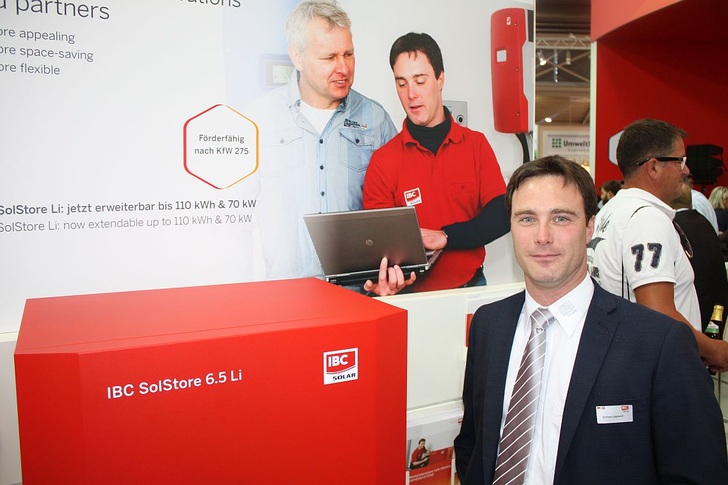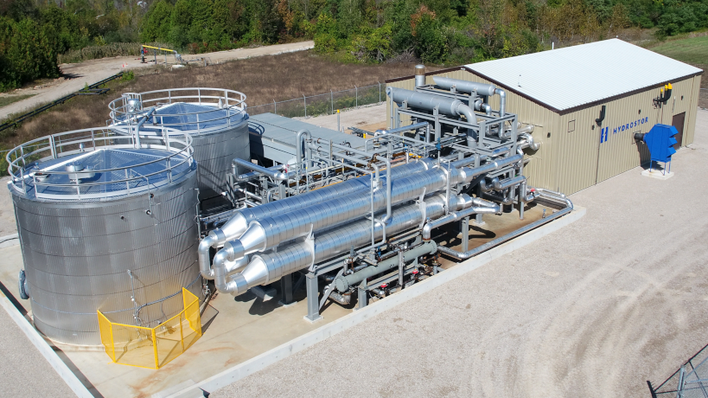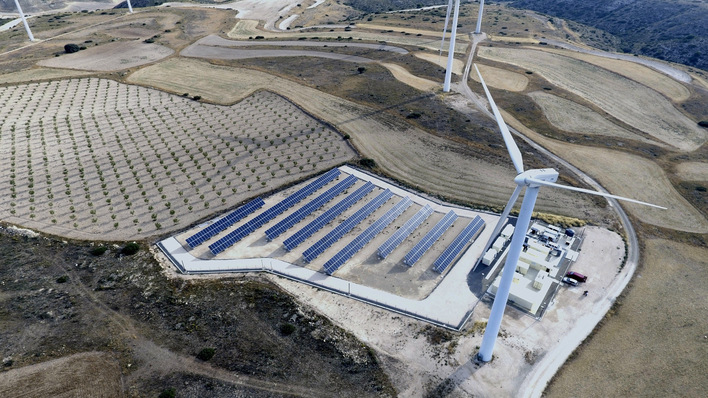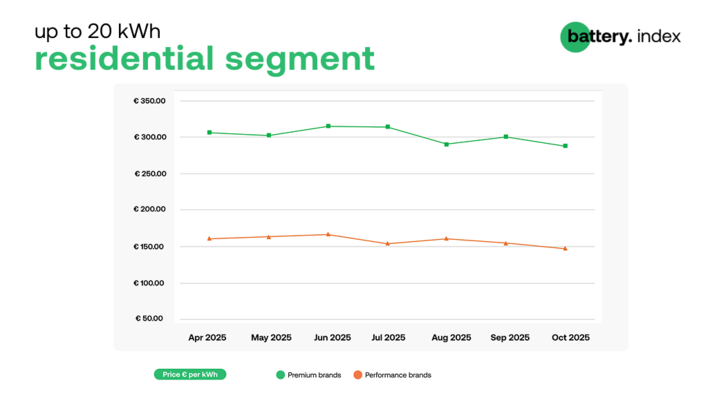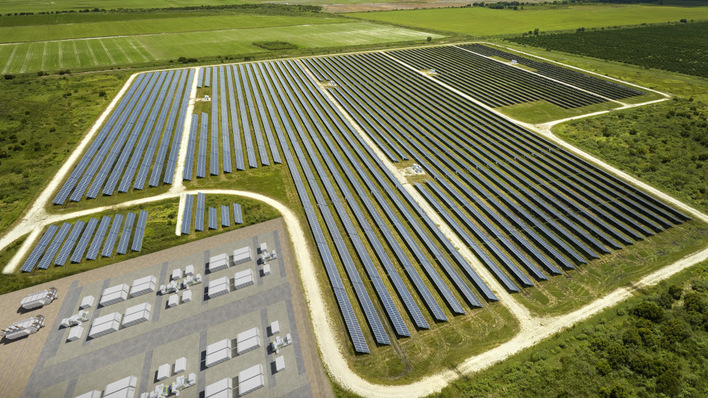You support the specialist partners of IBC Solar in planning and installing energy storage units as well as supervising the trainings. What exactly does your job entail?
Andreas Lipphardt: I support the service personnel in the field where the installation of particularly challenging storage solutions is concerned. I go out to the customers to supervise complicated systems and their integration. You can say I am something like a super substitute for our sales staff on the ground when it comes to technology. This has proven successful, with around 100 call outs per year.
The energy storage segment is only a few years old. How has the quality of the installation improved?
In the beginning it became clear that the systems were not simple enough. Quite often, batteries were designed at the wrong size, the cross-section of cables was wrong or the metres were integrated incorrectly. We at IBC Solar realised early on that the complexity of self-consumption systems should not be underestimated. Another good reason why it is important to talk to the future operator of the installation at an early stage about what is achievable, thereby making it possible to design the storage unit to be adequate to the desired use. Eventually, this will save all parties unnecessary service calls later on.
Energy storage systems are complex because they have a variety of applications. What is IBC Solar’s philosophy?
In contrast to other companies, our goal is not to provide the most straightforward plug-and-play system. With our IBC Solstores, we continue to provide a system that is a combination of different components and are thus suitable for a variety of uses. This is the AC-controlled battery management unit Sunny Island by SMA which can be combined with different batteries, either led batteries or lithium systems, single-phase or three-phase, with or without emergency power functionality – as well as being expanded as needed, tailored to the intended purpose. So in a sense, the correct installation of the storage unit begins as part of the first meeting with the end user, rather than when the battery modules are delivered to the building site. What is important is that a competent specialist is already involved in the first meeting, in order to find out if what the customer has in mind can actually be realised. As we see it, it is ideal for the person who eventually sets up the installation is the same person as planned it.
What technical issues during the installation of energy storage units do you notice regularly?
The key is controlling the battery. For that it is critical to have data on the electricity consumption of the building as a whole. In a private home, the metre is connected serially to the bidirectional metre at the point of connection to the grid, in order to include all consumers if possible. With larger units or storage facilities for commercial companies, it can be desirable to include the consumption of certain departments, i.e. hook up the metre to a specific sub-distribution unit. If the storage unit is only supposed to optimise self-consumption, it might be simpler depending on the circumstances. It is important for the technician to get a good idea of how to best connect the metre to the battery which, after all, might be located in a basement or in a far-off service room.
Or up in the attic?
A energy storage unit has no business being under the roof, even if it is cool and well-insulated. As a rule, the storage unit should be in a service room with easy access, ideally close to the electrical control cabinets, solar inverters and metres. The data cable from the metre measuring the self-consumption to the battery should be laid neatly and tidy, for instance in a cable duct on top of the plaster.
What electrical connection requirements need to be observed?
Prior to installation it is important to ascertain what currents flow through the sub-distribution unit and the cables, and whether they are right for the storage unit. Based on that, you need to select the appropriate cable cross-section. In case of back-up power supply, it is important to clearly decide if the emergency power is supposed to be for specific company departments or for all consumers. Back-up systems require two cables to the main connection point.
What requirements for AC wiring and fuses need to be met?
Of course, the cable cross-sections of the wiring needs to be sufficient. Where fuses are concerned it is important that the installing company pays attention that the fuses are of the proper dimension. The state of the art is currently to use circuit breakers rather than screw-in fuses. The latter can become loose over time and cause a greater thermal load.
How about the customers’ metres?
In general, existing metres cannot be used. So-called transformer-mounted metres often cause problems, because the way they are mounted needs to be taken into consideration. The direction the power flows is important. It can happen that transformers need to be turned around, and since they are often pushed onto copper rails, any rearrangement requires switching off the entire consumption system. Also, they need to be pre-fused, which might require the technician to access areas that only the utility has access to.
Is he allowed to do so just like that?
He needs to be certified according to the technical connection conditions of the utility and be registered in the directory of technicians of the grid operator. In case the installing company cannot do that itself, it needs to hire in a certified grid technician. Of course, this generates additional costs – which have to be openly communicated to the customer as part of the first quote.
The sensor measuring consumption is part of integrating the battery into the AC system. What kind of mistakes are made on the DC side?
That depends on the battery. Lead batteries are very heavy, so they need a foundation that is sound enough to take the weight. Lead-acid batteries require an enclosed basin, but we generally advise against them. Lead gel batteries are mostly used in case of larger-scale commercial storage. Just like lead-acid batteries, they require sufficient ventilation to get rid of the gases resulting from the reaction in the cells. The ventilation duct needs to be designed big enough.
And with lithium-ion batteries?
There it is easier. They are not as heavy or require as much housing, because ventilation is not necessary. For example, the battery management system for our Solstore 6.5 Li works without issues with SMA’s Sunny Island. All that is needed is the network cable and the two poles of the battery. Crucial for technicians: Take care not to change the length of cables without consulting the manufacturer.
How important is overvoltage protection?
We are bound by the insurers’ guidelines. For domestic installations we generally recommend a combination arrester, even though lightning or overvoltage protection is not mandatory for smaller residential buildings. The arrester protects the installation and thus also the storage unit. For public or commercial buildings, lightning protection for photovoltaics is mandatory. Here there are also other regulations and requirements as far as overvoltage protection of electrical systems are concerned.
What pitfalls are possible in the IT connection of storage units?
Storage units need to be connected to the Internet so that the operator and the technician can access the operation data and locate possible errors. The Internet connection also helps with using ‘smart’ functions, for example, weather-specific control of charging and consumption or dynamic regulation at the grid connection point. At activation, the technician needs to make sure that the most recent version of the firmware is installed – or, just in case, have the update with him. Also, he should have basic IT and network engineering skills. Wireless connections such as LTE has proven unreliable with some customers. This can result in complications, because the connection is lost on a regular basis. DSL is much more stabile, there are usually no problems. It the storage unit is installed at a company, the system administrator needs to define the correct authorisations in advance and assist in the IT-related integration of the unit.
What also needs to be considered at the point of activation?
I have already mentioned the correct firmware. The technician definitely needs to verify that the system configuration that is displayed in the web portal is actually the same as with the customer. It is important to instruct the operator in dealing with the operating states of his unit. Because the proper operation of the installation is the operator’s responsibility. A comprehensive instruction helps against unnecessary service calls. For instance, the customer needs to know how to get his unit out of standby mode, and crucially, such a briefing needs to be documented. In the case of lead batteries, the state of charge of each cell, i.e. their voltages at the point of activation, has to be recorded.
How important are these trainings for technicians?
We sell our storage systems only through IBC Solar-certified specialists. Once such technicians have themselves installed two or three storage units and have attended our trainings, they usually get on fine. They then are the sort of competent partners that we are looking for and that can represent the brand IBC Solar.
The interview was conducted by Heiko Schwarzburger.
Read more about energy storage
Stay informed, get our free newsletter, twice a week, register here
More useful information:
https://www.pveurope.eu/solar-storage/energy-storage-systems-need-be-lighter


